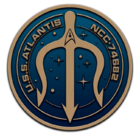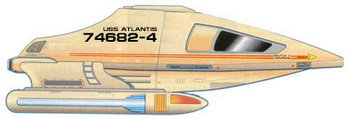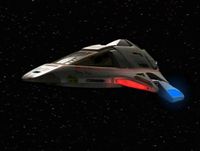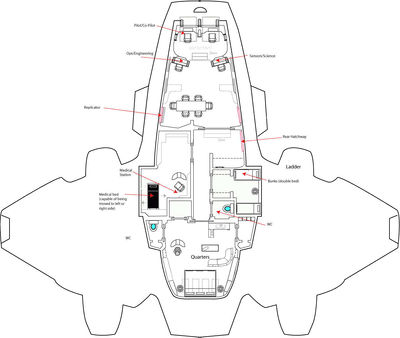Atlantis Small Craft Assignment
The USS Atlantis is equipped with a full complement of shuttles. She is equipped with two Type 8 and two Type 9 shuttles, which are capable of providing a variety of functions. Shuttles can be used for short to long range transportation, as well as for performing a variety of mission functions. Modern shuttles are equipped with warp engines as well as phasers.
Intrepid-class starships also come equipped with an Aeroshuttle.
Type 8 Shuttlecraft
Similar in design to Type 6 but slightly larger, it requires a piloting crew of two. It is equipped with a personnel transporter to allow short-range transportation. It has slightly enlarged twin warp nacelles compared to the Type 6 which is what gives it an extended travelling range over the Type 6. Its length and weight are otherwise similar to the Type 6, namely 6 meters and about 3.38 metric tonnes. Unlike the Type 6, the Type 8 is permanently equipped with phasers, with Type IV phaser emitters installed.
Type-8 Shuttlecraft
- Production Base: ASDB Integration Facility, Utopia Planitia Fleet Yards, Mars
- Accommodation: 2 flight crew; 6 passengers
- Dimensions:
- Length: 7 meters
- Beam: 4.4 meters
- Height: 2.7 meters
- Mass: 3.38 metric tons
- Performance: Warp 2
- Armament: Two type-4 phaser emitters
Atlantis' two Type 8 shuttlecraft are the Voltaire, and the Pembroke.
Type 9 Shuttlecraft
These are a more streamlined design, having a pointed front and larger warp nacelles, however it has less internal volume. It can be crewed by a single person if necessary but is outfitted for two pilots and four passengers. It has the greatest range of the shuttlecraft aboard Atlantis, with a maximum speed of warp 4. Length: 8.5 metres. Height: 2.95 metres. It is specifically designed for deep-space scouting missions, even though they are actually smaller than the Type 6.
Type-9 Shuttlecraft
- Production Base: ASDB Integration Facility, Utopia Planitia Fleet Yards, Mars
- Accommodation: 2 flight crew; 4 passengers
- Dimensions:
- Length: 8.45 meters
- Beam: 3.8 meters
- Height: 2.95 meters
- Mass: 1.85 metric tons
- Performance: Warp 4
- Armament: Two type-4 phaser emitters, 1 type-5 phaser emitter, 2 microtorpedo tubes
Atlantis' one Type 9 shuttlecraft is the Roanoke.
Type 11 Shuttlecraft
A far more streamlined design than the type-9, it is the most recent addition to Starfleet's array of shuttlecraft as of 2375. Based on a runabout's design, the Type-11 is twice the size of the Type-9, boasting a dorsal docking clamp and airlock. Type-11s are more heavily armed and shielded than the older shuttlecraft. It also is equipped with a transporter.
Type-11 Shuttlecraft
- Production Base: ASDB Integration Facility, Utopia Planitia Fleet Yards, Mars
- Accommodation: 2 flight crew; 10 passengers
- Dimensions:
- Length: 16.5 meters
- Beam: 8.8 meters
- Height: 3.81 meters
- Mass: 27.20 metric tons
- Performance: Warp 6
- Armament: Four type-5 phaser emitters; two microtorpedo launchers
Atlantis' two Type 11 shuttlecraft are the B'Hala, and the Elysium. The Elysium was commissioned in honor of the 27 crew that lost their lives during the bot attack on Atlantis in 2395.
Hawkeye class Scout Ship
The Atlantis also requisitioned a single Hawkeye class scout ship. The dual-crew vessel is primarily a mobile sensor platform, often used as a redundancy to the Atlantis' long range sensors, so Atlantis has no surprises in the war-riddled Expanse. Unlike the shuttles, the scout ship was not christened with a name, and is simply identified as "Hawkeye-1" in comm traffic.
AeroShuttle El Dorado(Hull AS-518)
The AeroShuttle is a large aerodynamic shuttle attached to Intrepid class starships.
The AeroShuttle is docked to the underside of the vessel's primary hull. When detached, it was capable of atmospheric flight as well as interplanetary travel at speeds up to warp 3. The AeroShuttle cockpit is designed for a crew of four.
An AeroShuttle was the term given to the ventrally docking subordinate craft of Intrepid-class starships. The craft was designed for atmospheric operations, and short-term missions as a support vessel, rather than as an independently operating small starship like the Danube class on which it is based.
- Length: 24.8 meters
- Beam: 29.6 meters
- Height: 4.1 meters
- Mass: 222.5 metric tons
- Impulse: 0.25c (0.5c with impulse thrusters for short duration bursts)
- Standard Warp: 3.0
- Maximum Sustainable Warp: 5.0 (36 hours)
Deck One
History
The AeroShuttle was initially conceived as a support craft for the Intrepid class, but some were also assigned to other starships and Starfleet installations. Construction of two prototypes began in 2369, closely followed by 15 production craft, seven of which were assigned to the new Intrepid class ships.
The AeroShuttle was then officially commissioned in 2370 and its success led to the development of the Waverider atmospheric operations shuttlecraft.
Specifications
In its basic configuration, the AeroShuttle was 24.8 meters long with a 29.6 meter wingspan, and displaced 222.5 metric tonnes. It could accommodate six crewmen on a standard two week mission. It was capable of effective operations within planetary atmospheres ranging from class D to class J and was highly maneuverable in flight. Its sensors were optimized for planetary surveys, but could also be used for reconnaissance or covert operations. All shipboard systems were controlled and monitored by an M-15 Isolinear III Processor.
Propulsion and navigation:
- The AeroShuttle was mounted with two LF-9X4 Advanced Compact Linear Warp Drive Units and two FIB-3 Compact Subatomic Unified Energy Impulse Units, which gave it a cruising speed of warp factor 3 and a maximum velocity of warp factor 5. The primary navigation system was provided by RAV/ISHAK Mod 3 Warp Celestial Guidance.
Weapons and defense:
- An FSQ-2 Primary Force Field and Deflector Control System provided the main defensive systems, while offensive weaponry included four Type VI collimated phaser arrays and two Mark 25 direct-fire photon microtorpedo tubes.








